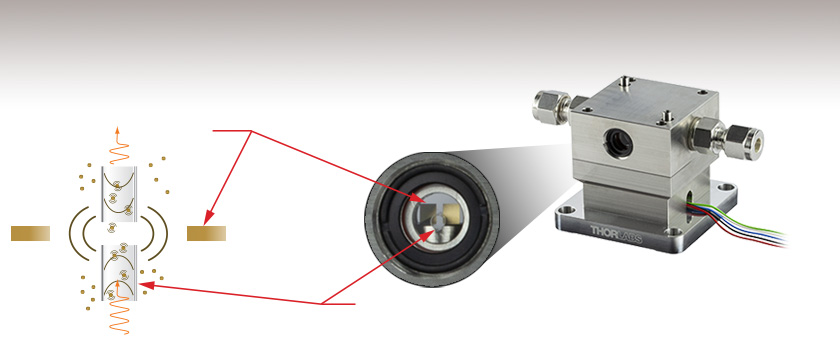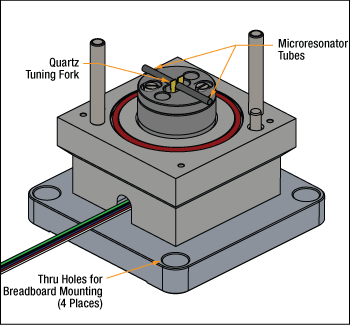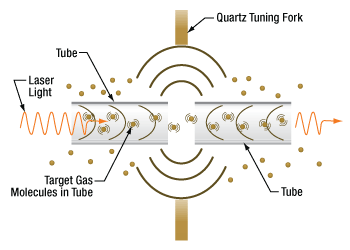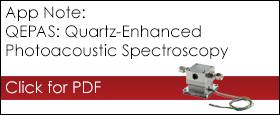Acoustic Detection Module for QEPAS

- Designed for Quartz-Enhanced Photoacoustic Spectroscopy (QEPAS)
- Acoustic Microresonator Tubes and Matched Preamplifier for Optimal SNR
- Custom Quartz Tuning Fork with 0.8 mm Prong Separation
- Low Resonance Frequency
- High Q Factor
ADM01
Acoustic Detection Module for QEPAS
Zoomed-In View Through Window
Quartz
Tuning
Fork
Microresonator Tubes
See QEPAS Tab for More Details

Please Wait

Click to Enlarge
Figure 1.1 Schematic Showing Module Interior
Features
- Includes Custom Quartz Tuning Fork, Microresonator (µR) Tubes, and Preamplifier with High Gain
- Low Resonance Frequency
- Q Factor at Atmospheric Pressure: >12000 (Typ.)
- Small Gas Sample Volume: 7 cm3
- Ø1/2" Uncoated BaF2 Wedged Windows for 200 nm - 11 µm
The Acoustic Detection Module is a photoacoustic cell designed to be easily built into a complete quartz-enhanced photoacoustic spectroscopy (QEPAS) system. The ADM01 module has an inlet and outlet allowing a gas sample to be pumped into the airtight chamber, which contains microresonator tubes and a custom quartz tuning fork (QTF). When an external laser source passes through the wedged windows, the tubes enhance the acoustic signal generated by the relaxation of the excited gas particles. This acoustic signal is transduced by the custom QTF and then amplified by the integrated high-gain preamplifier, enabling excellent signal-to-noise ratio. For more information on this technique, see the QEPAS tab.
The ADM01 module is designed to be incorporated into a complete QEPAS system. For customers wanting a full system, our QEPAS-CH4 is a complete, easy-to-use QEPAS sensor that uses the ADM01 acoustic module for methane detection. For more information on the QEPAS-CH4 and how the ADM01 is used in the system, please see the full presentation for our QEPAS Sensor for Methane Detection.
Gas Interface
Each ADM01 module is equipped with two gas connection ports. If not operated in a flow cell configuration, the second gas port could instead be used to connect a pressure gauge or other similar device to the cell. The gas ports are equipped with standard Hylok stainless steel tube fittings for 6 mm tubing. The tube fittings can be disconnected for access to the G1/8 straight female thread connector.
The Ø1/2" wedged windows for 200 nm - 11 µm are interchangeable to support additional wavelengths, and the microresonator tubes can be changed for measuring a different gas matrix than N2. Please contact us for assistance and details.
Mounting
As shown in Figure 1.1, four through holes are provided for securing the ADM01 module directly to metric or imperial breadboards. The bottom of the module also features an 8-32 (M4) tap for mounting to a PY005(/M) 5-Axis Stage on a PY005A1(/M) Slotted Mounting Plate. First mount the 5-axis stage to the slotted mounting plate and then mount the ADM01 module on top of the stage. Lastly, mount the entire assembly to the breadboard using the slots in the PY005A1 plate. The module also features several Ø2.1 mm (0.08") holes to serve as rotation locks. A single DIN915 screw fastened to the 6-32 taps of the 5-axis stage will lock the rotational position of the module when the smooth head of the DIN915 screw embeds into one of the four Ø2.1 mm holes.
Alignment
A laser source can be aligned to the ADM01 module by either beam steering via two mirrors or mounting the module to a multi-axis stage such as the PY005(/M) 5-axis stage. To prevent photothermal effects, the laser beam must not touch the walls of the tubes, so the beam diameter must be less than the inner diameter of 1.6 mm. A power sensor may be used before and after the module to assess the power lost and ensure the beam has not contacted the walls of the tubes. A lens might also be used to focus the laser light at the plane of the QTF to optimize signal strength.
| Electrical Connections | ||
|---|---|---|
| Color | Purpose | Comment |
| Red | +12 V | Recommended Voltage, up to 24 V Maximum |
| Black | GND | - |
| Blue | -12 V | Recommended Voltage, up to 24 V Maximum |
| White | MODULATION IN | Electrical Modulation (sine) IN for QTF Characterization |
| Green | SIGNAL OUT | Amplified QTF Signal OUT Linear up to 1.8 V, 50 Ω Termination |
| ADM01 Specifications | |
|---|---|
| Resonance Frequency f0 a | 12455 Hz (Typ.) |
| Q Factora | >12000 (Typ.) |
| Volume of Sample Chamber | 7 cm3 |
| Microresonator Tubes (2) | Inner Diameter: 1.6 mm Length, Each: 12.4 mm |
| Wedged Windowsb (2) | WW00530 Uncoated BaF2, 200 nm - 11 µm |
| Gas Connectors | G1/8 Straight for 6 mm Tubing |
| Recommended Gas Flow | <200 sccm |
| Maximum Gas Pressure | 1.5 bar |

Click to Enlarge
Figure 3.1 QEPAS Diagram
Photoacoustic spectroscopy is a technique based on the photoacoustic effect that is able to accurately detect trace gas concentrations for a wide variety of applications. Similar to laser absorption spectroscopy, a laser beam is sent through a gastight chamber to excite the target gas molecules. However, instead of detecting the absorption lines with an optical detector, the pressure wave generated by the relaxation of those molecules is detected by a transducer.
In the case of quartz-enhanced photoacoustic spectroscopy (QEPAS), the transducer is a sharply resonant quartz tuning fork (QTF). The high-Q acoustic resonance enables the detection of weak excitation within small volumes, bypassing the acoustic resonance restrictions of conventional methods. When the laser source is modulated with a sine wave, the induced pressure (sound) wave will have double the frequency as that of the light modulation; therefore, the laser source modulation must be at half of the resonance frequency of the QTF. The resulting amplitude from the QTF is directly proportional to the concentration of trace gas in the sample.
The QTF also has good environmental noise immunity due to its being an acoustic quadrupole, since the primary vibrational modes require the prongs to move away from each other to be piezoelectrically active. Sound from external sources has a longer wavelength than the prong separation and will cause the prongs to move in the same direction, resulting in no piezoelectric response.
For more information on the science of QEPAS, please see the Publications tab.
ADM01 Acoustic Detection Module
The ADM01 module is designed for on-axis QEPAS, which uses two tubes on either side of the QTF as an acoustic microresonator which the light must pass through, as shown in Figure 3.1. Each tube has a length of ~λ/2, where λ is the wavelength of sound in air at the resonance frequency of the tuning fork, and there is a small gap between them for the QTF. The acoustic resonator increases the effective interaction length between the generated sound and the QTF, allowing the QTF to have greater sensitivity to the near-field photoacoustic wave.
Select Publications on Quartz-Enhanced Photoacoustic Spectroscopy
The following publications provide further information on the principles and applications of QEPAS. For more information, we suggest visiting the website of our strategic partners at PolySense, a joint industry-university research lab between Thorlabs and the Technical University of Bari focused on the research and development of innovative optical gas sensing systems.
2023
R. De Palo, A. Elefante, G. Biagi, F. Paciolla, R. Weih, V. Villada, A. Zifarelli, M. Giglio, A. Sampaolo, V. Spagnolo, and P. Patimisco, "Quartz-Enhanced Photoacoustic Sensors for Detection of Eight Air Pollutants," Adv. Photonics Res. 4, 2200353 (2023)
2022
H. Lin, Y. Liu, L. Lin, W. Zhu, X. Zhou, Y. Zhong, M. Giglio, A. Sampaolo, P. Patimisco, F.K. Tittel, J. Yu, V. Spagnolo, and H. Zheng, "Application of standard and custom quartz tuning forks for quartz-enhanced photoacoustic spectroscopy gas sensing," App. Spec. Rev. 57, (2022)
A. Sampaolo, P. Patimisco, M. Giglio, A. Zifarelli, H. Wu, L. Dong, and V. Spagnolo, "Quartz-enhanced photoacoustic spectroscopy for multi-gas detection: A review," Anal. Chim. Acta 1202, 338894 (2021)
2021
P. Patimisco and V. Spagnolo, "Quartz-Enhanced Photoacoustic Spectroscopy for Trace Gas Sensing," Encycl. Anal. Chem. 1-17, (2021)
2020
A. Sampaolo, G. Menduni, P. Patimisco, M. Giglio, V.M.N. Passaro, L. Dong, H. Wu, F.K. Tittel, and V. Spagnolo, "Quartz-Enhanced Photoacoustic Spectroscopy for Hydrocarbon Trace Gas Detection and Petroleum Exploration," Fuel 227, 118118 (2020)
2018
P. Patimisco, A. Sampaolo, L. Dong, F.K. Tittel, and V. Spagnolo, "Recent advances in quartz enhanced photoacoustic sensing," App. Phys. Rev. 5, 011106 (2018)
2016
P. Patimisco, A. Sampaolo, H. Zheng, L. Dong, F.K. Tittel, and V. Spagnolo, "Quartz-enhanced photoacoustic spectrophones exploiting custom tuning forks: a review," Adv. Phys. X 2, 169-187 (2016)
2014
P. Patimisco, G. Scamarcio, F.K. Tittel and V. Spagnolo, "Quartz-Enhanced Photoacoustic Spectroscopy: A Review," Sensors 14, 6165-6206 (2014)
| Posted Comments: | |
Zhou Li
(posted 2025-03-10 11:19:18.537) Hi! We purchased your product ADM01 for gas detection. During laser alignment, we built an imaging system to ensure that the light spot entered the tube. However, the transmitted power is less than expected. The total transmittance of the ADM01 is only 71%, which is smaller than the possible optical loss caused by the wedged window. What do you think could possibly be the problem? Could you offer some guidelines? jjadvani
(posted 2025-03-11 03:48:39.0) Dear Zhou, Thank you for contacting Thorlabs. My colleague will contact you directly to troubleshoot your issue. user
(posted 2023-12-20 16:44:40.343) 尊敬的先生/女士, 我正在与您联系以获取有关 adm 模块的更多信息,并获得有关我们的光声光谱实验设置的建议。 你能通过电子邮件与我联系吗? nreusch
(posted 2023-12-21 02:54:33.0) Thank you for contacting Thorlabs. An applications engineer from our team in China (techsupport-cn@thorlabs.com) has reached out to you directly regarding this.
感谢联系Thorlabs!来自中国的技术支持同事(techsupport-cn@thorlabs.com)将直接与您联系沟通。 Eda Güney
(posted 2023-11-10 14:18:08.433) Dear Sir/Madam,
I am contacting you to get more information about adm modules and get suggestions about our photoacoustic spectroscopy experimental setup.
Could you please contact me via e-mail?
Best soswald
(posted 2023-11-10 07:50:14.0) Dear Eda,
thank you for your feedback. I have reached out to you directly to discuss your setup in detail. user
(posted 2023-10-30 20:50:44.05) Hii,
1)How to characterize the QTF?
2)Can we change the QTF with a customized QTF version?
3)Dimensions of the QTF? nreusch
(posted 2023-10-30 11:50:01.0) Thank you for your feedback. 1) It is important to characterize the QTF and to determine the resonance frequency under the measurement conditions in your project. For doing so, the white MODULATION IN wire should be employed. A sinus signal will be applied between GND and this wire and the frequency should be swept. The resonance frequency is then detected as a peak in the response of the SIGNAL OUT/green wire. A typical voltage would be 200 mV pp. 2) The combination of QTF and micro resonator tubes was optimized during development. Therefore, we do not recommend exchanging the QTF. If your application requires a different QTF design, we will need to discuss whether our mechanics and electronics would still be a good match for project. 3) We can provide the dimensions of the QTF. I will reach out to you to discuss all of the above in more detail. Aritra Pal
(posted 2023-06-01 20:11:01.143) Can you please post a picture of the entire QEPAS setup where we can see where to place the ADM01, above what should we place. I am actually unable to fix the ADM01 on the MTA translation stage...actually I am not even sure if I should place it there only... soswald
(posted 2023-06-01 09:23:53.0) Dear Aritra,
thank you for your feedback. I have reached out to you directly to discuss your setup in detail. user
(posted 2023-04-25 21:40:57.607) Hello, I was wondering if it is possible to use the ADM module with the harmonics of the resonance frequency, and if it is possible, how this affects the signal. Is this something that has been tested before? Thank you for your assistance. soswald
(posted 2023-04-26 05:36:05.0) Thank you for your feedback. In principle the QEPAS technique can be used for dual-gas detection using the harmonics of the resonance frequency of the quartz tuning fork as separate detection channels.
However, the signal intensity of the higher harmonics is much lower than the fundamental, so this requires a quartz tuning fork specifically designed and optimized for this purpose, which the standard quartz tuning fork incorporated into the ADM01 is not. user
(posted 2023-04-11 16:56:59.14) I'm curious about what material is used on the electrodes deposited on the quartz tuning fork, to possibly use this unit to detect corrosive gases at low concentrations. What are the electrodes made of? soswald
(posted 2023-04-12 04:47:09.0) Thank you for your feedback. The electrodes are made of gold. I have reached out to you directly to discuss your application in detail. user
(posted 2022-06-07 17:37:05.363) Is there a diagram or explanation available describing how the input modulation works? What exactly is the modulation affecting, and how is it transduced by the QCTF and amplified by the TIA? mdiekmann
(posted 2022-06-23 02:41:24.0) The input modulation is a sine with user set amplitude (typ. 100-300mV) and frequency. The amplitude is scaled down on the preamplifier. This excites the QTF and depending on how well the frequency corresponds to the resonance frequency, the QTF gives a signal which is is amplified by the TIA in the same way it would if it was excited by a laser.
Please do not hesitate to reach out to your local tech support team in case you have further questions. 李 玉林
(posted 2021-09-14 15:05:34.77) 请问ADM01成套装置只需要接入准直出来的可调激光(例如1653nm)就可以得到测量结果吗?不需要其他配件了吧? dpossin
(posted 2021-09-21 09:09:56.0) Dear Customer,
Thank you for your feedback. Well thats right. The measurement can be done right away as long as you have an tunable collimated laser. KwangHoon Ko
(posted 2021-05-20 20:13:57.183) I have an ADM01 QEPAS cell and I am connecting the wires of QEPAS now. But there's no maximum voltage amplitude and frequency for modulation input (white wire) in manual. So, please let me know the operation voltage (amplitude) for modulation input.
And about the frequency, I think the frequency is 12455 Hz. Please confirm this.
Thanks. dpossin
(posted 2021-05-21 05:31:23.0) Dear KwangHoon Ko,
Thank you for your inquiry. We use 300mV in order to characterize the QTF. In front of the TIA, there is an voltage divider which scales the input voltage down to factor 1/285. In order to find out the maximum modulation input at MOD IN you can start with 300mV and while continously measure the output voltage slowly increase the modulation voltage until 1.8V is reached at the amplified output. At this point and above the TIA leaves the linear regime and stops working above 2.2V. I am reaching out to you in order to discuss this further. J.-F. Lampin
(posted 2021-03-09 09:28:23.167) Dear Thorlabs,
Your QUEPAS is very interesting but I can not modulate my MIR source. A solution would be to chop the beam but your chopper as a maximum frequency of 10 kHz which is lower than the resonant frequency of the QEPAS (12.4 kHz). Do you see a solution ?
Thanks. dpossin
(posted 2021-03-12 07:33:56.0) Dear Jean Francois,
Thank you for your feedback. It is not absolutely neccessary to modulate the laser incident to the ADM01 module in the time domain. Another technique is to modulate the laser in the spectral regime with half the resonant frequency of the quarz tuning fork. This is our preferred technique and I guess most of our customers use the QUEPAS module this way. I am reaching out to you to discuss this further. Michał Pawlak
(posted 2020-08-06 04:49:36.65) Is it possible to do the sample holder for solid sample? circles around 1 cm in diamieter and 1mm thinck? dpossin
(posted 2020-08-11 05:47:28.0) Dear Michal,
Thank you for your feedback. As the ADM01 is an QUEPAS system (please see a brief introduction to the principle here: LINK) which only works for gases the placement of solid samples does not make sense. I reached out to your in order to further discuss your application. Ryan Sun
(posted 2020-05-27 04:25:02.667) Dear Thorlabs, I am trying to lower the pressure inside the ADM01 to 1Torr.
I want to know if the ADM01's window can withstand a relative pressure of almost 1atm and if it can be repaired if it breaks.
I completed the test from 1.5bar to 0.5bar pressure, but the experiment was stopped because I was not sure whether the ADM01 could work normally at a pressure of 0.5bar or less.
Please explain the exact limit of the window installed in ADM01.
Thank you :) wskopalik
(posted 2020-06-04 06:54:09.0) This is a response from Wolfgang at Thorlabs. Thank you for your inquiry!
The windows in the ADM01 can withstand a pressure of 1 Torr on the inside. We have tested the ADM01 successfully with low pressures in this range. There would however need to be continuous gas flow and pumping at such low pressures to keep the pressure low. In the case of static measurements at low pressures, the pressure would rise quickly, i.e. you would draw air from the outside.
In case of a damage, the windows can easily be exchanged. The windows WW00530 are used in the ADM01 which are available in our catalog.
I will contact you directly to provide further assistance. yazhou wang
(posted 2020-04-23 14:01:50.773) Hello,
It mentioned that: 'When the laser source is modulated with a sine wave, the induced pressure (sound) wave will have double the frequency as that of the light modulation; therefore, the laser source modulation must be at half of the resonance frequency of the quartz tuning fork (QTF).'
I feel confused that why the induced pressure (sound) wave will have double the frequency as that of the light modulation. Cloud you please give some comments on this? Thanks! dpossin
(posted 2020-05-04 04:22:19.0) Dear Customer,
Thank you for your feedback. Well, for photoacoustic purposes the frequency of the incident laser light is modulated. Therefore the absorption line of the gas inside the QUEPAS cell is hit twice within one full modulation wave. One time in the first half wave when the laser wavelenght rises and a second time in the second half wave when the laser wavelenght drops again. The vibronic movement of the gas leads to sound waves which have double the modulation frequency of those of the incident laser light. To make sure, that the resonance frequency of the quartz tuning fork (QTF) is met, the modulation of the incident laser must be half the resonance frequency of the QTF. Because the bandwith of the QTF is quite narrow it is crucial that the resonance freqency is hit.
I am reaching out to you for further discussion. Mincheol Jeon
(posted 2020-02-02 19:48:57.607) Hello Thorlabs, in sepcs, its maximum gas pressure is 1.5bar. But how about in vacuum? Is it possible to measure gas with adm01 even in vacuum? Thank you! dpossin
(posted 2020-02-19 08:16:39.0) Dear customer,
Thank you for your feedback. There are many things to care of when you like to evacuate the ADM01 chamber. As an example I will enlarge on two different topics:
Leakage:
How good the vacuum can be depends very much on the leakage rate and the power of the pump. Leakage rate is given by the seals of the ADM01 cell itself and also on the fact if and how much the inner components are outgasing. As we did not tested the ADM01 for that purpose we can not say if vacuum can be applied there. However the Entrance and output windows withstand the ambient pressure.
Limit of detection (LOD):
The limit of detection also depends on the pressure as for lower gas pressure or even vacuum, there won´t be ambient gas any more which transmits the vibrational movements onto the tuning fork. As an result, most probably the LOD will decrease. Ryan Sun
(posted 2020-01-13 03:50:37.59) Dear Thorlabs, Could you explain to me what is the current's range(ampere) required by the power supply of ADM01? nreusch
(posted 2020-01-14 02:04:48.0) This is a response from Nicola at Thorlabs. Thank you for contacting us. The current consumption is about 20-30 mA. Mincheol Jeon
(posted 2019-12-06 03:21:37.25) Dear Thorlabs, could you please inform the drawing or size of the QTF?(ex. width, length of each tine and length between two tines...) Thank you! nreusch
(posted 2019-12-09 02:30:37.0) This is a response from Nicola at Thorlabs. Thank you for your feedback. You can download the AutoCAD file by clicking on the red document icon next to the item number and then choosing the Auto CAD PDF document or any other file format that you are interested in. Please contact your local Tech Support team if any information is missing. Mincheol Jeon
(posted 2019-11-11 04:56:58.69) I want to know what kind of the electrical modulation(sine) IN for QTF characterization.(voltage modulation? or current modulation..) And I want to know how much modulation input I have to put in. Best regards, Mincheol. dpossin
(posted 2019-11-12 03:21:26.0) Hello Mincheol,
Thank you for your feedback. To characterize the QTF an sine signal between 3 and 50 mV (peak to peak) shall be applied. The actual voltage level depends on the pressure inside the measuring cell. To find the resonance frequency of the QTF one should start with a frequency slightly below 12455 Hz and slowly increase the frequency until resonant vibration is found. Please note that the applied voltage into the MODULATION IN is reduced by an factor of 256 via an voltage divider before it reaches the QTF. Mincheol Jeon
(posted 2019-11-11 04:53:01.51) I want to know what kind of the electrical modulation(sine) IN for QTF characterization.(voltage modulation? or current modulation..) Best regards, Mincheol. Jean-Michel Melkonian
(posted 2019-09-20 08:41:50.633) Dear Thorlabs,
could you please update the specs of ADM01 to confirm whether it can be pumped down to near vacuum, because in relative pressure this results in -1 bar. Thank you. MKiess
(posted 2019-10-14 06:08:23.0) This is a response from Michael at Thorlabs. Thank you for the Feedback.
We stated 1.5bar maximum pressure since that was up to now the maximum we tested with QEPAS measurements and are confident that it works.
In terms of vacuum the lower limit depends on two factors: the tightness of the ADM01 and the pump that is used to evacuate. The strongest pump we have in our labortory brought us to the lower limit. The pressure sensor we have can measured 1Torr.
Therefore, it would be worth considering changing the pressure specifications as follows: 1mbar to 1.5 bar (absolute pressure), i.e. from 1 Torr to 1125 Torr. Ryan Sun
(posted 2019-09-09 16:37:17.883) I wonder if the Maximum Gas Pressure in the specifications is absolute or relative.
And what is the available temperature range of the module?
Please explain these things,
Best Regards.
Ryan dpossin
(posted 2019-09-10 09:10:56.0) Hello Ryan,
Thank you for your feedback. In general, the epoxy adhesive limits the mechanical use of the ADM module. The specified temperature range of this adhesive is from -40°C up to +90°C. Further the noise of the integrated pre amplifier shows higher noise with respect to increasing temperature. The temperature range for this part is -40°C up to 125°C.
The specified pressure is given in absolute value. |
 Products Home
Products Home

















 Acoustic Detection Module
Acoustic Detection Module